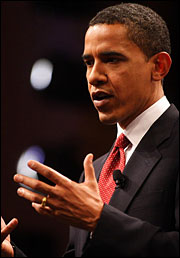In a post earlier today I argued that “official” estimates of how much climate/energy legislation will cost are likely systematically overstating costs and understating benefits.
It’s worth noting that this is not an idiosyncratic opinion of mine. It is shared by President Obama, his team, and key Democratic leaders, and helps explain some of the strategy around Waxman-Markey.
For evidence, check out this fantastic and candid interview Obama, Energy Secretary Steven Chu, and climate adviser Caorl Browner did with a group of reporters. Here’s Obama saying, in various ways, that he thinks clean energy will emerge much faster than official projections estimate:
I think what we’re going to see is … all the nay-sayers are proven wrong because American ingenuity and technology moves a lot faster when incentives are in place. … I think this is going to end up being much less costly, much more efficient; technology is going to move much more rapidly than people anticipate. … I think what seems controversial now is going to seem like common sense in hindsight. …
This is quite similar to what Pelosi told Grist in an interview last year:
Once the [clean energy] private sector takes off, I think this conversation [on drilling] will look very, very stale and old. … I believe that whatever the [renewable energy standard] percentage is, it will take off. It will take off.
How does this optimism about clean energy feed into strategy on climate legislation? Obama never says it flat out, but at several points he indicates that he and his team are willing to accept some of the weaknesses in Waxman-Markey because they believe, basically, that nothing succeeds like success. Once the clean energy sector takes off, innovations start rolling out, household bills start falling thanks to efficiency, Congress will be more likely to return to the system with more ambition. He says:
[W]e are going to have — be able in this process to take a look at what kind of progress are we making five years from now, 10 years from now, 15 years from now. With the framework now in place we may find ourselves not only able, but eager to move on that even more ambitious program.
And again later, even more explicitly:
My strong belief is that innovation and technology are going to accelerate our process beyond these targets, and that we’re going to look back and say we can do even more. But I think legitimately people want to make sure that we are not setting such high goals without having even put a framework into place that it — well, let me phrase it this way: I think legitimately people want the framework in place and for us to make strong, steady, gradual progress, as opposed to trying to shoot for the moon and not being able to get anything done.
In other words: get the framework in place, watch the market exceed expectations, and then return to the framework in a more politically congenial climate.
It makes me nervous — it’s an act of great faith in American business — but I don’t see any other road forward.


